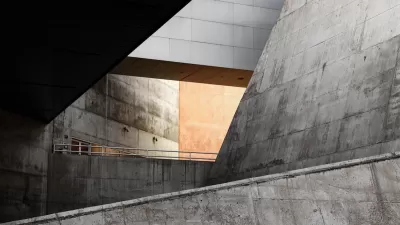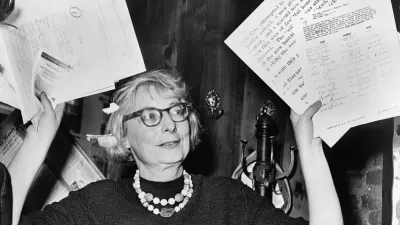The machine-city envisioned by Le Corbusier, and made into practice in decades of modernist bureaucracy, has ultimately produced, according to Simon Richards' essay, an antisocial environment, against which urban planning seems to be now reacting.
"Why is socializing in cities taken to be a good thing? Why do we assume it is beneficial for people to experience urban variety, opportunity, and intrigue? These are not questions normally asked, and it feels perverse to frame them as questions. Still, we have not always been so sure about socializing in cities. We have forgotten the negative argument - that the unregulated social life of large cities is a corrupting influence best avoided. It had never occurred to me to raise these questions until I began research on Le Corbusier. At the same time that he is celebrated as the visionary architect of such modernist masterpieces as the Villa Savoye (1928) and the pilgrimage chapel at Ronchamp (1955), he is decried as an irresponsible and perhaps mentally disturbed city planner. In his Plan Voisin from 1925, for example, Le Corbusier proposed to demolish the center of Paris and replace it with towers in parkland. The prospect of German cities bombed flat by the Allies during World War II made him envious - the Germans were able to rebuild from ground zero. (Incidentally, many British planners offered thanks to the Luftwaffe for returning the favor.) He made plans that would mean (as he put it himself) the "Death of the Street." In proposing the elimination of side alleys and shops, in granting limited space for cafés, community centers, and theaters, in dispersing them over great distances, and constructing them of uninviting concrete, glass, and steel, Le Corbusier expressed his contempt for the teeming hubbub that urbanists now esteem "
Thanks to Alessandro Busa'
FULL STORY: The Antisocial Urbanism of Le Corbusier

Florida Considers Legalizing ADUs
Current state law allows — but doesn’t require — cities to permit accessory dwelling units in single-family residential neighborhoods.

Manufactured Crisis: Losing the Nation’s Largest Source of Unsubsidized Affordable Housing
Manufactured housing communities have long been an affordable housing option for millions of people living in the U.S., but that affordability is disappearing rapidly. How did we get here?

Research Shows More Roads = More Driving
A national study shows, once again, that increasing road supply induces additional vehicle travel, particularly over the long run.

EV Chargers Now Outnumber Gas Pumps by Nearly 50% in California
Fast chargers still lag behind amidst rapid growth.

Affordable Housing Renovations Halt Mid-Air Amidst DOGE Clawbacks
HUD may rescind over a billion dollars earmarked for green building upgrades.

Has Anyone at USDOT Read Donald Shoup?
USDOT employees, who are required to go back to the office, will receive free parking at the agency’s D.C. offices — flying in the face of a growing research body that calls for pricing parking at its real value.
Urban Design for Planners 1: Software Tools
This six-course series explores essential urban design concepts using open source software and equips planners with the tools they need to participate fully in the urban design process.
Planning for Universal Design
Learn the tools for implementing Universal Design in planning regulations.
City of Moreno Valley
Institute for Housing and Urban Development Studies (IHS)
City of Grandview
Harvard GSD Executive Education
City of Piedmont, CA
NYU Wagner Graduate School of Public Service
City of Cambridge, Maryland





























